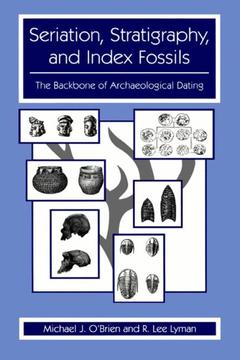Seriation, Stratigraphy, and Index Fossils, Softcover reprint of the original 1st ed. 1999 The Backbone of Archaeological Dating
Langue : Anglais
Auteurs : O'Brien Michael J., Lyman R. Lee

It is difficult for today's students of archaeology to imagine an era when chronometric dating methods were unavailable. However, even a casual perusal of the large body of literature that arose during the first half of the twentieth century reveals a battery of clever methods used to determine the relative ages of archaeological phenomena, often with considerable precision.
Stratigraphic excavation is perhaps the best known of the various relative-dating methods used by prehistorians. Although there are several techniques of using artifacts from superposed strata to measure time, these are rarely if ever differentiated. Rather, common practice is to categorize them under the heading `stratigraphic excavation'. This text distinguishes among the several techniques and argues that stratigraphic excavation tends to result in discontinuous measures of time - a point little appreciated by modern archaeologists.
Although not as well known as stratigraphic excavation, two other methods of relative dating have figured important in Americanist archaeology: seriation and the use of index fossils. The latter (like stratigraphic excavation) measures time discontinuously, while the former - in various guises - measures time continuously. Perhaps no other method used in archaeology is as misunderstood as seriation, and the authors provide detailed descriptions and examples of each of its three different techniques.
Each method and technique of relative dating is placed in historical perspective, with particular focus on developments in North America, an approach that allows a more complete understanding of the methods described, both in terms of analytical technique and disciplinary history. This text will appeal to all archaeologists, from graduate students to seasoned professionals, who want to learn more about the backbone of archaeological dating.
Stratigraphic excavation is perhaps the best known of the various relative-dating methods used by prehistorians. Although there are several techniques of using artifacts from superposed strata to measure time, these are rarely if ever differentiated. Rather, common practice is to categorize them under the heading `stratigraphic excavation'. This text distinguishes among the several techniques and argues that stratigraphic excavation tends to result in discontinuous measures of time - a point little appreciated by modern archaeologists.
Although not as well known as stratigraphic excavation, two other methods of relative dating have figured important in Americanist archaeology: seriation and the use of index fossils. The latter (like stratigraphic excavation) measures time discontinuously, while the former - in various guises - measures time continuously. Perhaps no other method used in archaeology is as misunderstood as seriation, and the authors provide detailed descriptions and examples of each of its three different techniques.
Each method and technique of relative dating is placed in historical perspective, with particular focus on developments in North America, an approach that allows a more complete understanding of the methods described, both in terms of analytical technique and disciplinary history. This text will appeal to all archaeologists, from graduate students to seasoned professionals, who want to learn more about the backbone of archaeological dating.
1. An Introduction to Time and Dating. Preliminary Considerations. Relative and Absolute Time. Continuous and Discontinuous Time. Direct and Indirect Dating. Scientific Dating. Time and Its Measurement. Nominal Scale Measurement. Ordinal Scale Measurement. Ordinal Scale Measurement. Interval Scale Measurement. Ratio Scale Measurement. Beyond Measurement Scale: Ideational and Empirical Units. 2. The Creation of Archaeological Types. Initial Considerations. Constructing Chronological Types. Chronological Types in Americanist Archaeology. Typological issues Begin to Take Shape. Typology in Retrospect. 3. Seriation I: Historical Continuity, Heritable Continuity, and Phyletic Seriation. What Is Seriation? Seriation in Americanist Archaeology. The Key Assumptions: Historical and Heritable Continuity. Continuity and the Study of Organisms. Tracing Lineages. Detecting Heritable Continuity. Historical Continuity, Heritable Continuity, and the Study of Artifacts. Culture Traits. W.M. Flinders Petrie and Artifacts from Egyptian Tombs. John Evans and Gold Coins from Britain. A. V. Kidder and Pottery from Pecos Pueblo. The Gladwin-Colton-Hargrave System. Projectile Point Evolution. 4. Seriation II: Frequency Seriation and Occurrence Seriation. The First Frequency Seriation. How Do Occurrence and Frequency Seriation Work? The Seriation Model. Requirements and Conditions of Seriation. Occurrence Seriation. Frequency Seriation. Meeting the Conditions of the Seriation Model. Temporal Resolution and Rates of Change. Absolute Seriation. A Final Note. 5. Superposition and Stratigraphy: Measuring Time Discontinuously. Strata, Stratigraphy, and Superposition. Stratigraphic Excavation. Stratigraphic Excavation in Historical Context. Early Stratigraphic Excavation. On the Eve of the `Revolution'. The Real Revolution. What Was the Revolution? After the Revolution: Measuring Time with Strata. Measuring Time at Gatecliff Shelter, Nevada. The Final Proof Is in the Spade, But. 6. Cross Dating: The Use of Index Fossils. Folsom and Clovis Points. George C. Vaillant and the Mexican Formative. James A. Ford and the Lower Mississippi Valley. Measuring Time Discontinuously. 7. Final Thoughts on Archaeological Time: A Cash of Two Metaphysics. Measuring Time Continuously. Measuring Time Discontinuously. Concluding Remarks. References. Index.
Date de parution : 03-2013
Ouvrage de 253 p.
15.5x23.5 cm
Disponible chez l'éditeur (délai d'approvisionnement : 15 jours).
Prix indicatif 105,49 €
Ajouter au panierMots-clés :
Stratigraphy; artifacts; chronometric dating; seriation; typology
© 2024 LAVOISIER S.A.S.



